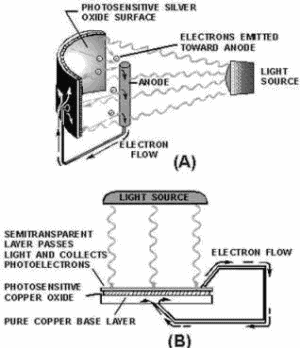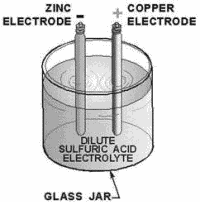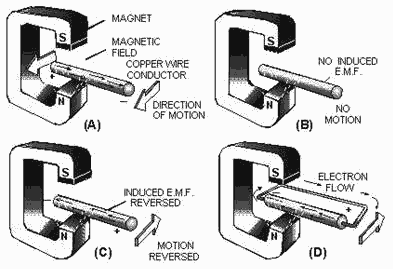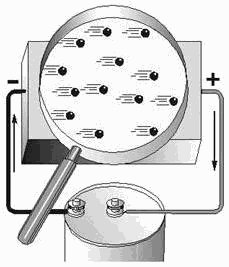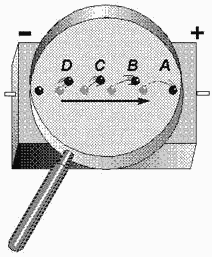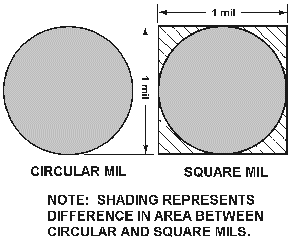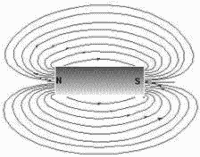Module 1 - Introduction to Matter, Energy, and Direct Current |
||||||||||||||||||||||||||||||||||||||||||||||||||
|
Module 1 − Introduction to Matter, Energy, and Direct Current
Pages i, 1−1, 1−11, 1−21, 1−31, 1−41, 1−51, 1−61, 2−1, 2−11, 2−21, 3−1, 3−11, 3−21, 3−31, 3−41, 3−51, 3−61, 3−71, 3−81, 3−91, 3−101, 3−111, 3−121, Appendix I, II, III, IV, V, Index
Figure 1-22. - Voltage produced by light. The cell (fig. 1-22 view A) has a curved light-sensitive surface focused on the central anode. When light from the direction shown strikes the sensitive surface, it emits electrons toward the anode. The more intense the light, the greater the number electrons emitted. When a wire is connected between the filament and the back, or dark side the cell, the accumulated electrons will flow to the dark side. These electrons will eventually pass through the metal the reflector and replace the electrons leaving the light- sensitive surface. Thus, light energy is converted to a flow electrons, and a usable current is developed. The cell (fig. 1-22 view B) is constructed in layers. a base plate pure copper is coated with light- sensitive copper oxide. An extremely thin semitransparent layer metal is placed over the copper oxide. This additional layer serves two purposes: 1. It permits the penetration light to the copper oxide. 2. It collects the electrons emitted by the copper oxide. An externally connected wire completes the electron path, the same as in the reflector-type cell. The photocell's voltage is used as needed by connecting the external wires to some other device, which amplifies (enlarges) it to a usable level. The power capacity a photocell is very small. However, it reacts to light-intensity variations in an extremely short time. This characteristic makes the photocell very useful in detecting or accurately
1-31 controlling a great number operations. For instance, the photoelectric cell, or some form the photoelectric principle, is used in television cameras, automatic manufacturing process controls, door openers, burglar alarms, and so forth. Voltage Produced by Chemical Action Voltage may be produced chemically when certain substances are exposed to chemical action. If two dissimilar substances (usually metals or metallic materials) are immersed in a solution that produces a greater chemical action on one substance than on the other, a difference potential will exist between the two. If a conductor is then connected between them, electrons will flow through the conductor to equalize the charge. This arrangement is called a primary cell. The two metallic pieces are called electrodes and the solution is called the electrolyte. The voltaic cell illustrated in figure 1-23 is a simple example a primary cell. The difference potential results from the fact that material from one or both the electrodes goes into solution in the electrolyte, and in the process, ions form in the vicinity the electrodes. Due to the electric field associated with the charged ions, the electrodes acquire charges.
Figure 1-23. - Voltaic cell. The amount difference in potential between the electrodes depends principally on the metals used. The type electrolyte and the size the cell have little or no effect on the potential difference produced. There are two types primary cells, the wet cell and the dry cell. In a wet cell the electrolyte is a liquid. a cell with a liquid electrolyte must remain in an upright position and is not readily transportable. An automotive battery is an example this type cell. The dry cell, much more commonly used than the wet cell, is not actually dry, but contains an electrolyte mixed with other materials to form a paste. Flashlights and portable radios are commonly powered by dry cells. Batteries are formed when several cells are connected together to increase electrical output.
1-32 Voltage Produced by Magnetism Magnets or magnetic devices are used for thousands different jobs. One the most useful and widely employed applications magnets is in the production vast quantities electric power from mechanical sources. The mechanical power may be provided by a number different sources, such as gasoline or diesel engines, and water or steam turbines. However, the final conversion these source energies to electricity is done by generators employing the principle electromagnetic induction. These generators, many types and sizes, are discussed in other modules in this series. The important subject to be discussed here is the fundamental operating principle ALL such electromagnetic-induction generators. To begin with, there are three fundamental conditions which must exist before a voltage can be produced by magnetism. 1. There must be a CONDUCTOR in which the voltage will be produced. 2. There must be a Magnetic FIELD in the conductor's vicinity. 3. There must be relative motion between the field and conductor. The conductor must be moved so as to cut across the magnetic lines force, or the field must be moved so that the lines force are cut by the conductor. In accordance with these conditions, when a conductor or conductors MOVE ACROSS a magnetic field so as to cut the lines force, electrons WITHIN The CONDUCTOR are propelled in one direction or another. Thus, an electric force, or voltage, is created. In figure 1-24, note the presence the three conditions needed for creating an induced voltage.
Figure 1-24. - Voltage produced by magnetism. 1. a magnetic field exists between the poles the C-shaped magnet. 2. There is a conductor (copper wire). 3. There is a relative motion. The wire is moved back and forth ACROSS the magnetic field.
1-33 In figure 1-24 view A, the conductor is moving TOWARD the front the page and the electrons move from left to right. The movement the electrons occurs because the magnetically induced EMF acting on the electrons in the copper. The right-hand end becomes negative, and the left-hand end positive. The conductor is stopped at view B, motion is eliminated (one the three required conditions), and there is no longer an induced EMF. Consequently, there is no longer any difference in potential between the two ends the wire. The conductor at view C is moving away from the front the page. An induced EMF is again created. However, note carefully that the REVERSAL MOTION has caused a REVERSAL DirectION in the induced EMF. If a path for electron flow is provided between the ends the conductor, electrons will leave the negative end and flow to the positive end. This condition is shown in part view D. Electron flow will continue as long as the EMF exists. In studying figure 1-24, it should be noted that the induced EMF could also have been created by holding the conductor stationary and moving the magnetic field back and forth. The more complex aspects power generation by use mechanical motion and magnetism are discussed later in this series, under the heading "Generators and Motors." Q40. Name the six methods producing a voltage. Q41. The piezoelectric effect is an example a voltage being produced by what method?
Q42. a thermocouple is a device that produces voltage by what method?
Q43. a battery uses what method to produce a voltage?
Q44. a generator uses what method to produce a voltage? ELECTRIC CURRENT It has been proven that electrons (negative charges) move through a conductor in response to an electric field. ELECTRON CURRENT FLow will be used throughout this explanation. Electron current is defined as the directed flow electrons. The direction electron movement is from a region negative potential to a region positive potential. Therefore electric current can be said to flow from negative to positive. The direction current flow in a material is determined by the polarity the applied voltage. Note: In some electrical/electronic communities, the direction current flow is recognized as being from positive to negative. Q45. According to electron theory, an electric current flows from what potential to what potential? Random Drift All materials are composed atoms, each which is capable being ionized. If some form energy, such as heat, is applied to a material, some electrons acquire sufficient energy to move to a higher energy level. As a result, some electrons are freed from their parent atom's which then becomes ions. Other forms energy, particularly light or an electric field, will cause ionization to occur. The number free electrons resulting from ionization is dependent upon the quantity energy applied to a material, as well as the atomic structure the material. At room temperature some materials, classified as conductors, have an abundance free electrons. Under a similar condition, materials classified as insulators have relatively few free electrons. In a study electric current, conductors are major concern. Conductors are made up atoms that contain loosely bound electrons in their outer orbits. Due to the effects increased energy, these outermost electrons frequently break away from their atoms and freely drift throughout the material. The
1-34 free electrons, also called mobile electrons, take a path that is not predictable and drift about the material in a haphazard manner. Consequently such a movement is termed RandOM DRIFT. It is important to emphasize that the random drift electrons occurs in all materials. The degree random drift is greater in a conductor than in an insulator. Directed Drift Associated with every charged body there is an electrostatic field. Bodies that are charged alike repel one another and bodies with unlike charges attract each other. An electron will be affected by an electrostatic field in exactly the same manner as any negatively charged body. It is repelled by a negative charge and attracted by a positive charge. If a conductor has a difference in potential impressed across it, as shown in figure 1-25, a direction is imparted to the random drift. This causes the mobile electrons to be repelled away from the negative terminal and attracted toward the positive terminal. This constitutes a general migration electrons from one end the conductor to the other. The directed migration mobile electrons due to the potential difference is called DirectED DRIFT.
Figure 1-25. - Directed drift. The directed movement the electrons occurs at a relatively low VELOCITY (rate motion in a particular direction). The effect this directed movement, however, is felt almost instantaneously, as explained by the use figure 1-26. As a difference in potential is impressed across the conductor, the positive terminal the battery attracts electrons from point A. Point a now has a deficiency electrons. As a result, electrons are attracted from point B to point A. Point B has now developed an electron deficiency, therefore, it will attract electrons. This same effect occurs throughout the conductor and repeats itself from points D to C. At the same instant the positive battery terminal attracted electrons from point A, the negative terminal repelled electrons toward point D. These electrons are attracted to point D as it gives up electrons to point C. This process is continuous for as long as a difference potential exists across the conductor. Though an individual electron moves quite slowly through the conductor, the effect a directed drift occurs almost instantaneously. As an electron moves into the conductor at point D, an electron is leaving at point A. This action takes place at approximately the speed a light (186,000 miles Per Second).
1-35
Figure 1-26. - Effect directed drift. Q46. The effects directed drift take place at what rate speed? Magnitude Current Flow Electric current has been defined as the directed movement electrons. Directed drift, therefore, is current and the terms can be used interchangeably. The expression directed drift is particularly helpful in differentiating between the random and directed motion electrons. However, CURRENT FLow is the terminology most commonly used in indicating a directed movement electrons. The magnitude current flow is directly related to the amount energy that passes through a conductor as a result the drift action. An increase in the number energy carriers (the mobile electrons) or an increase in the energy the existing mobile electrons would provide an increase in current flow. When an electric potential is impressed across a conductor, there is an increase in the velocity the mobile electrons causing an increase in the energy the carriers. There is also the generation an increased number electrons providing added carriers energy. The additional number free electrons is relatively small, hence the magnitude current flow is primarily dependent on the velocity the existing mobile electrons. The magnitude current flow is affected by the difference potential in the following manner. Initially, mobile electrons are given additional energy because the repelling and attracting electrostatic field. If the potential difference is increased, the electric field will be stronger, the amount energy imparted to a mobile electron will be greater, and the current will be increased. If the potential difference is decreased, the strength the field is reduced, the energy supplied to the electron is diminished, and the current is decreased. Q47. What is the relationship current to voltage in a circuit? Measurement Current The magnitude current is measured in Amperes. a current one ampere is said to flow when one coulomb charge passes a point in one second. Remember, one coulomb is equal to the charge 6.28 x 1018 electrons.
1-36 Frequently, the ampere is much too large a unit for measuring current. Therefore, the MILLIAmpere (mA), one-thousandth an ampere, or the MICROAmpere ( μA), one-millionth an ampere, is used. The device used to measure current is called an AMMETER and will be discussed in detail in a later module. Q48. Convert 350 mA to amperes. ELECTRICAL Resistance It is known that the directed movement electrons constitutes a current flow. It is also known that the electrons do not move freely through a conductor's crystalline structure. Some materials offer little opposition to current flow, while others greatly oppose current flow. This opposition to current flow is known as Resistance (R), and the unit measure is the OHM. The standard measure for one ohm is the resistance provided at zero degrees Celsius by a column mercury having a cross-sectional area one square millimeter and a length 106.3 centimeters. a conductor has one ohm resistance when an applied potential one volt produces a current one ampere. The symbol used to represent the ohm is the Greek letter omega ( Ω ). Resistance, although an electrical property, is determined by the physical structure a material. The resistance a material is governed by many the same factors that control current flow. Therefore, in a subsequent discussion, the factors that affect current flow will be used to assist in the explanation the factors affecting resistance. Q49. What is the symbol for ohm? Factors That Affect Resistance The magnitude resistance is determined in part by the "number free electrons" available within the material. Since a decrease in the number free electrons will decrease the current flow, it can be said that the opposition to current flow (resistance) is greater in a material with fewer free electrons. Thus, the resistance a material is determined by the number free electrons available in a material. A knowledge the conditions that limit current flow and, therefore, affect resistance can now be used to consider how the type material, physical dimensions, and temperature will affect the resistance a conductor. TYPE MATERIAL. - Depending upon their atomic structure, different materials will have different quantities free electrons. Therefore, the various conductors used in electrical applications have different values resistance. Consider a simple metallic substance. Most metals are crystalline in structure and consist atoms that are tightly bound in the lattice network. The atoms such elements are so close together that the electrons in the outer shell the atom are associated with one atom as much as with its neighbor. (See fig. 1-27 view A). As a result, the force attachment an outer electron with an individual atom is practically zero. Depending on the metal, at least one electron, sometimes two, and in a few cases, three electrons per atom exist in this state. In such a case, a relatively small amount additional electron energy would free the outer electrons from the attraction the nucleus. At normal room temperature materials this type have many free electrons and are good conductors. Good conductors will have a low resistance.
1-37
Figure 1-27. - Atomic spacing in conductors. If the atoms a material are farther apart, as illustrated in figure 1-27 view B, the electrons in the outer shells will not be equally attached to several atoms as they orbit the nucleus. They will be attracted by the nucleus the parent atom only. Therefore, a greater amount energy is required to free any these electrons. Materials this type are poor conductors and therefore have a high resistance. Silver, gold, and aluminum are good conductors. Therefore, materials composed their atoms would have a low resistance. The element copper is the conductor most widely used throughout electrical applications. Silver has a lower resistance than copper but its cost limits usage to circuits where a high conductivity is demanded. Aluminum, which is considerably lighter than copper, is used as a conductor when weight is a major factor. Q50. When would silver be used as a conductor in preference to copper? EFFECT CROSS-SECTIONAL AREA. - Cross-sectional area greatly affects the magnitude resistance. If the cross-sectional area a conductor is increased, a greater quantity electrons are available for movement through the conductor. Therefore, a larger current will flow for a given amount applied voltage. An increase in current indicates that when the cross-sectional area a conductor is increased, the resistance must have decreased. If the cross-sectional area a conductor is decreased, the number available electrons decreases and, for a given applied voltage, the current through the conductor decreases. a decrease in current flow indicates that when the cross-sectional area a conductor is decreased, the resistance must have increased. Thus, the Resistance a CONDUCTOR Is INVERSELY PROPORTIONAL to ITS CROSS-SECTIONAL AREA. The diameter conductors used in electronics is ten only a fraction an inch, therefore, the diameter is expressed in mils (thousandths an inch). It is also standard practice to assign the unit circular mil to the cross-sectional area the conductor. The circular mil is found by squaring the diameter when the diameter is expressed in mils. Thus, if the diameter is 35 mils (0.035 inch), the circular
1-38 mil area is equal to (35) 2 or 1225 circular mils. a comparison between a square mil and a circular mil is illustrated in figure 1-28.
Figure 1-28. - Square and circular mils. EFFECT CONDUCTOR LENGTH. - The length a conductor is also a factor which determines the resistance a conductor. If the length a conductor is increased, the amount energy given up increases. As free electrons move from atom to atom some energy is given f as heat. The longer a conductor is, the more energy is lost to heat. The additional energy loss subtracts from the energy being transferred through the conductor, resulting in a decrease in current flow for a given applied voltage. a decrease in current flow indicates an increase in resistance, since voltage was held constant. Therefore, if the length a conductor is increased, the resistance increases. The Resistance of a CONDUCTOR Is DirectLY PROPORTIONAL to ITS LENGTH. Q51. Which wire has the least resistance? Wire A-copper, 1000 circular mils, 6 inches long. Wire B-copper, 2000 circular mils, 11 inches long. EFFECT TEMPERATURE. - Temperature changes affect the resistance materials in different ways. In some materials an increase in temperature causes an increase in resistance, whereas in others, an increase in temperature causes a decrease in resistance. The amount change resistance per unit change in temperature is known as the TEMPERATURE COEFFICIENT. If for an increase in temperature the resistance a material increases, it is said to have a Positive TEMPERATURE COEFFICIENT. a material whose resistance decreases with an increase in temperature has a Negative TEMPERATURE COEFFICIENT. Negative TEMPERATURE COEFFICIENT. Most conductors used in electronic applications have a positive temperature coefficient. However, carbon, a frequently used material, is a substance having a negative temperature coefficient. Several materials, such as the alloys constantan and manganin, are considered to have a ZERO TEMPERATURE COEFFICIENT because their resistance remains relatively constant for changes in temperature. Q52. Which temperature coefficient indicates a material whose resistance increases as temperature increases?
1-39 Q53. What term describes a material whose resistance remains relatively constant with changes in temperature? CONDUCTANCE Electricity is a study that is frequently explained in terms opposites. The term that is the opposite resistance is CONDUCTANCE. Conductance is the ability a material to pass electrons. The factors that affect the magnitude resistance are exactly the same for conductance, but they affect conductance in the opposite manner. Therefore, conductance is directly proportional to area, and inversely proportional to the length the material. The temperature the material is definitely a factor, but assuming a constant temperature, the conductance a material can be calculated. The unit conductance is the MHO (G), which is ohm spelled backwards. Recently the term mho has been redesignated SIEMENS (S). Whereas the symbol used to represent resistance (R) is the Greek letter omega ( Ω ), the symbol used to represent conductance (G) is (S). The relationship that exists between resistance (R) and conductance (G) or (S) is a reciprocal one. a reciprocal a number is one divided by that number. In terms resistance and conductance:
Q54. What is the unit conductance and what other term is sometimes used?
Q55. What is the relationship between conductance and resistance? ELECTRICAL ResistorS
Resistance is a property every electrical component. At times, its effects will be undesirable. However, resistance is used in many varied ways. ResistorS are components manufactured to possess specific values resistance. They are manufactured in many types and sizes. When drawn using its schematic representation, a resistor is shown as a series jagged lines, as illustrated in figure 1-29.
1-40
|
||||||||||||||||||||||||||||||||||||||||||||||||||
